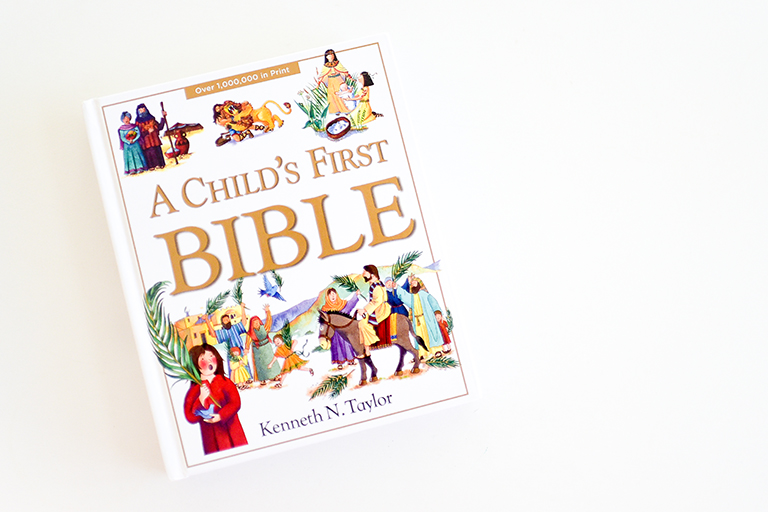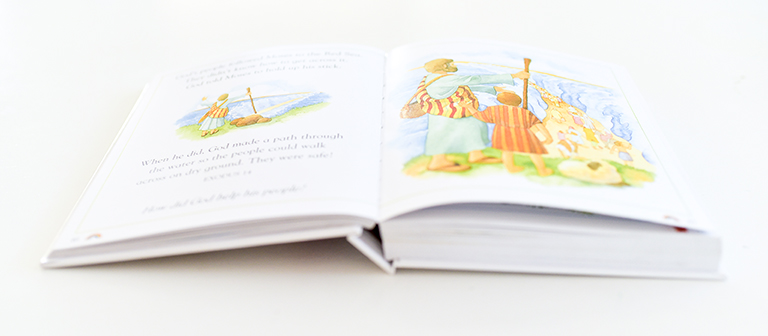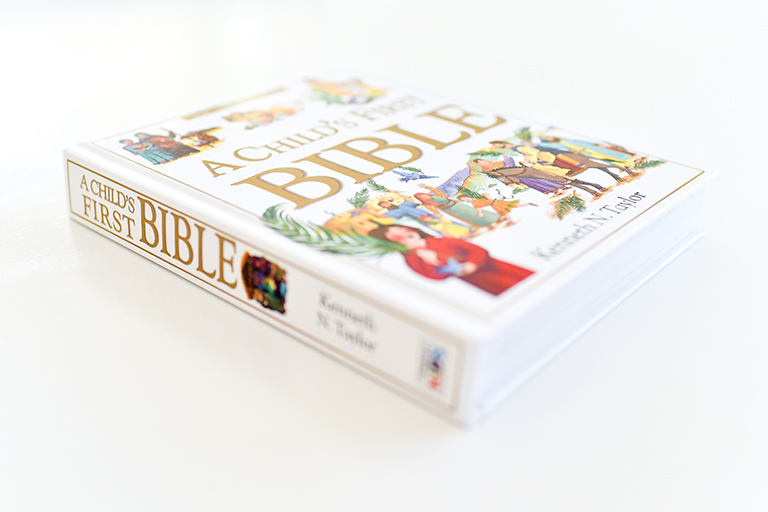A Child’s First Bible is one of so many children’s Bibles. It’s easy to feel overwhelmed by the variety and unsure of which is best for your bookshelf. So, here at ICM, we’ve compiled some of our thoughts and recommendations in this blog series where we’ll be reviewing some of today’s most popular children’s Bibles. Once you find your fave children’s Bible, check out our post on ways of reading scripture with your kids to get the most out of it!

Quick Facts about A Child’s First Bible
- 255 pages
- 125 classic biblical passages
- Question for each story
- Age Range: 4-8 years old
- Top Seller on Amazon

A Closer Look
There’s no perfect choice for all children everywhere or even for your own child. Each one is a mix of aspects to love as well as those that invite palm to forehead moments. In this series of reviews, we’ll always include what we surmise to be the pros and cons of each Bible and whether or not we’d recommend it to our friends. So, let’s dive in and take a closer look at A Child’s First Bible!
Pros of A Child’s First Bible
Engaging Illustrations: Illustrators Nadine Wickenden and Diana Catchpole did a nice job creating consistently colorful, engaging illustrations for young children. They assist children in imagining the biblical texts as they read.
Digestible Story Length: The stories are short, which makes it easy to hold the attention of young readers.
Large Font Size: The text is sized appropriately for young children who are learning to read either along with their parents or on their own.
Classic Stories Included: All the classic stories you hope for from children’s Bibles are included here.
Name Plate Included: Inside the front cover, there is a nameplate page included for gifting it to a child. A children’s director, teacher, or family member would appreciate this.
Compact Size: As far as children’s Bibles go, this is a small one. Stowing it in a bag for church or travel would be easy for that reason.

Cons of A Child’s First Bible
Lacking Table of Contents: Having a table of contents would allow for easy reading if a child has a selection of favorite stories they want to keep revisiting. Additionally, if a teacher or parent wants to refer to a particular story it’s incredibly difficult to find.
Lacking Story Titles: What makes it even more difficult to locate a particular story is the lack of story titles. Also, the absence of delineation between stories makes for confusing reading for adults and especially for children. There’s no cue except for narrative flow to signal a story’s end/beginning. Even between the Hebrew and Greek Scriptures there is no divide. Nehemiah ends on one page with “God kept their enemies away.” and the following page begins with Luke 1: “God sent the angel Gabriel to tell Mary something very important.”
Inaccurate Illustrations: The illustrations, though colorful and engaging, are not culturally appropriate. Characters are almost exclusively white with classically European features. And there are a lot of Irish-looking dudes with pale skin and red hair. This obviously isn’t what the biblical characters looked like.
Less Than Ideal Questions: The question for each story leaves something to be desired. They are mostly obvious comprehension questions that do not “highlight important biblical truths” as the product description asserts. There are a few helpful exceptions. For example, “Tell about a time God answered one of your prayers.” And there are a few simply unhelpful ones. For example, “Do you have a Bible? Then God’s rules are near you!” An important note here: The Bible is not a rule book for living our lives. Rather, it is a library of various interpretations of human nature and divine action across genres and contexts. Teaching our children that it is simply a rule book will be confusing, frustrating, and irreconcilable when contradictions and disturbing rules of past eras become apparent in their future reading.
Exclusively Masculine Language for God: God is neither male nor female but possesses a nature far more complex and integrated. If we are to use one gender to metaphorically describe God then we must use all genders. If not, using non-gendered language for God is ideal. This is standard practice in most seminaries; there is no reason it shouldn’t be common practice in the pulpit and faith education.

Conclusion
Children’s Bibles are all different, each with desirable qualities. And this Bible has some good things going for it. It is colorful, includes the classic stories you’d hope to see, and has a nameplate for gifting to a child. The stories are short and the font size is large, both good for young readers. However, there are several key things that detract from it. First, navigating through the book isn’t easy without a table of contents. Second, the narratives of each story are difficult to separate without story titles. Third, the characters are almost all white. Fourth, the story questions aren’t all that helpful. Fifth and lastly, the author uses gendered language for God that is exclusively male. So, in spite of it being a top seller on Amazon and boasting over 1,000,000 copies in print, we wouldn’t recommend A Child’s First Bible for young children.

Leave a Reply